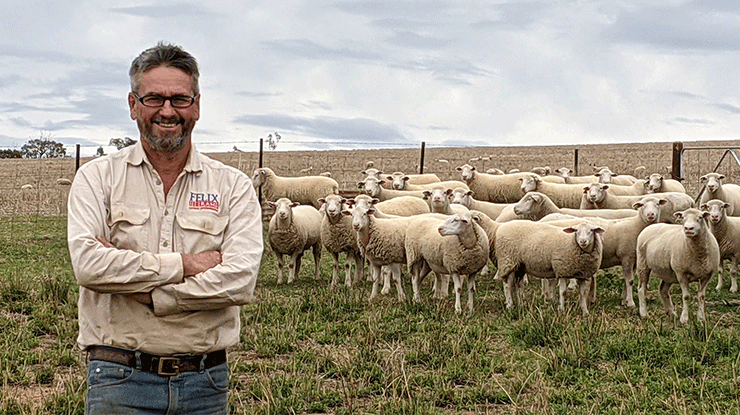Eating quality an important trait for ram breeders
12 May 2021

Breeding rams that not only perform in the paddock but also produce lambs that ultimately meet the eating quality expectations of consumers is an important consideration for ram breeder, Rodney Watt.
Based at Greenethorpe in Central West NSW, Rodney, Liz and Isaac Watt operate Felix Rams, breeding and selling Poll Dorset and White Suffolk rams. In addition to their ram breeding operations, they also produce prime lambs and grow wheat and canola with a focus on graze and grain.
The Watts are Meat Standards Australia (MSA) accredited producers and have been collecting performance data on their flocks for more than 30 years. They were among the early adopters of LAMBPLAN (Sheep Genetics) Australian Sheep Breeding Values (ASBVs) in the 1990s.
While achieving gains in major production traits, the Watts included selecting for eating quality traits in 2011 after identifying a declining trend in eating quality.
Insights key to improvement
Rodney said from both a business and industry perspective, monitoring eating quality is an important part of the overall approach to achieving gains in every trait.
“In 2010, we had a Poll Dorset ram as a sire that was very good for muscle but came back with very poor eating quality measurements. Soon after that, we had a White Suffolk who was at the other extreme end who was very good, so we saw the spectrum of what was there,” Rodney said.
“At the time, our focus was muscle and growth and we realised that if we continued down that path and didn’t take any notice of eating quality, lamb sired by our rams could head in the direction of not delivering a great eating experience.
“I’m in the business of selling the best rams possible and I want to attract the best clients. As soon as the industry, in general, started talking about eating quality and I saw we had a bad ram and a good ram, I saw eating quality as another way of keeping or increasing market share, as well as being the right thing to do for the industry.”
Finding the right balance
The Felix Rams Poll Dorset flock has an annual joining of 550 ewes while the White Suffolk flock has an annual joining of 250. The Watts also join about 200 ewe lambs across both breeds.
“Our breeding objective is to take a balanced approach to structure and ASBVs,” Rodney said.
“We aim to breed structurally sound, low to moderate birthweight, early maturing sheep, with adequate fat, and low worm egg counts while also improving lean meat yield and eating quality.”
The Watts use targeted ASBVs to select for eating quality traits. They also genotype to improve the accuracy of the eating quality traits through genomics.
On-farm, they measure birthweight, lambing ease, growth rate, fat, muscle, individual worm egg counts, combined with progeny carcase testing and genotyping to enhance ASBVs for lean meat yield, intra-muscular fat (marbling) and shear force (tenderness).
Meeting your customers’ needs
“We have promoted eating quality to our clients right from the get-go, and I think a fair percentage of our clients recognise we’re doing the right thing and heading in the right direction,” Rodney said.
Rodney said that as the market signals for eating quality are not quite there yet, the breeding focus is not a priority for some producers.
“At the end of the day we’ve got to sell the product. There’s no point having great sheep if no one wants to buy them to eat,” Rodney said.
“And it is the same for a ram breeder – there is no point having great eating quality rams if their growth rate or muscle is below expectations, and you can’t sell them. We’ve got to meet a range of expectations.
“There’s the expectations of the producer wanting an easy finishing lamb that’s going to be a moderate birth weight so there’s no issues lambing, that will grow and finish quickly. Then there’s the current processor demands for the amount of red meat (lean meat yield). And then there are the eating quality expectations of the consumer.
“It’s all about balance. With the sort of technologies we use on-farm to breed better rams, we have the capacity to rapidly make change and put more emphasis on eating quality if that was what the market identifies and demands. In the meantime, it is just steady progress, and eliminating the sires identified as poor for eating quality.”
For more information on using ASBVs to select for eating quality, visit genetics.mla.com.au
For a full list of MSA requirements for sheepmeat producers, visit mla.com.au/msa


